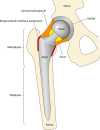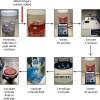Prosthetic joint infection
- PMID: 24696437
- PMCID: PMC3993098
- DOI: 10.1128/CMR.00111-13
Prosthetic joint infection
Abstract
Prosthetic joint infection (PJI) is a tremendous burden for individual patients as well as the global health care industry. While a small minority of joint arthroplasties will become infected, appropriate recognition and management are critical to preserve or restore adequate function and prevent excess morbidity. In this review, we describe the reported risk factors for and clinical manifestations of PJI. We discuss the pathogenesis of PJI and the numerous microorganisms that can cause this devastating infection. The recently proposed consensus definitions of PJI and approaches to accurate diagnosis are reviewed in detail. An overview of the treatment and prevention of this challenging condition is provided.
Figures






References
-
- Centers for Disease Control and Prevention. 2013. National hospital discharge survey: 2010 table, procedures by selected patient characteristics. Centers for Disease Control and Prevention, Atlanta, GA: http://www.cdc.gov/nchs/data/nhds/4procedures/2010pro4_numberprocedureag...
-
- Havelin LI, Fenstad AM, Salomonsson R, Mehnert F, Furnes O, Overgaard S, Pedersen AB, Herberts P, Karrholm J, Garellick G. 2009. The Nordic Arthroplasty Register Association: a unique collaboration between 3 national hip arthroplasty registries with 280,201 THRs. Acta Orthop. 80:393–401. 10.3109/17453670903039544 - DOI - PMC - PubMed
Publication types
MeSH terms
Substances
Grants and funding
LinkOut - more resources
Full Text Sources
Other Literature Sources
Medical

